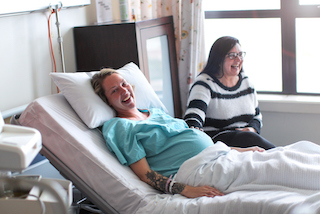Seven ways labor and delivery has changed for the better
April 17, 2018

Events surrounding childbirth have changed over the years. Expecting moms today now face a different experience than what their mothers and grandmothers saw. Pregnancy and childbirth once were just seen as medical problems or illnesses. Many women today view pregnancy and delivery as a personal life experience and not merely an episode of medical care.
Fortunately, the changes are for the better, and we have the benefit of research and expertise to help improve the childbirth experience in a safe way. In other words, this is not your mother’s labor – for patients and providers alike, it’s a whole new way of thinking about the experience of bringing new life into the world.
In 2017, the World Health Organization (WHO) provided recommendations for women to have a positive childbirth experience. The goal is to put women at the center of care, enhance the pregnancy experience, and ensure their babies have a healthy, positive start in life. I’ve put together a list of highlights from those endorsements. While you can’t control every aspect of pregnancy and delivery, you can use this list to help create a positive childbirth experience of your own.
How things have changed
1. Women are encouraged to have a companion during labor
Research has consistently demonstrated that women value and benefit from the presence of someone they trust during labor and recovery. This isn’t like “I Love Lucy,” in which Ricky went to work and showed up at the hospital after Little Ricky was born! For many women, having a support person during labor is vital.
Decide who you want to ask to be part of your birth experience – for example, a partner, parent, close friend, midwife, or doula. People might give you recommendations or try to influence your choice, but go with your heart about who would make you feel most at ease.
2. We know labor sometimes can take longer than expected
Even before you start having contractions, the cervix begins to change. Ten centimeters is considered fully dilated, when the cervix is open enough for the baby to pass into the birth canal. Throughout the years, health care providers have disagreed on how fast a patient’s cervix should change and when to decide she needs help.
In the past, the rule of thumb was one centimeter every hour. Now, it’s recognized that this might be too fast for some women – that is perfectly normal. The recommendations note that a slower rate of dilation shouldn’t prompt automatic interventions such as medication to induce more contractions or a cesarean section (C-section). Labor often can take as long as 12 hours for a first delivery and 10 hours for women who’ve previously given birth.
This is not your mother’s labor – for patients and providers alike, it’s a whole new way of thinking about the experience of bringing new life into the world.
3. Enemas are less important
In years past, doctors sometimes recommended having an enema – a procedure to clear out your bowel – before labor began. But we’ve found over time that it’s not really helpful or necessary. The new guidelines suggest that enemas not be used routinely.
4. Some women can skip the fetal monitor
If you are healthy and considered low risk, you and your doctor might decide that a fetal monitor isn’t necessary. Instead, intermittent checks of the baby’s heart should be sufficient. However, if you’re being induced, the doctor will probably recommend continuous fetal monitoring to be on the safe side.
5. Pain medications aren’t pushed like they used to be
If you’re not interested in a delivery that involves medications, that's fine. Relaxation and mindfulness techniques, such as using lavender or other essential oils, as well as proper breathing and soothing music, are common pain medication alternatives.
Epidural anesthesia and intravenous pain medications are also options, depending on your preference. Make sure to talk to your doctor beforehand to determine which is best for you because every situation is different.
6. Eating and drinking right before labor is probably OK
Talk to your provider and delivery location about their policies regarding eating and drinking during labor. For years, many health care practices didn’t allow women to drink or eat anything but ice chips. Today, we allow clear liquids and certain snacks, such as juice, popsicles, and Jell-O. If you’re not at high risk for a C-section, you should have this option.
7. Women are encouraged to move more before and after delivery
In decades past, women were recommended to stay in bed after childbirth. That’s why maternity hospitals were frequently called “lying-in” hospitals. Today we know that getting active as soon as possible can help control the risk of dangerous blood clots. Before birth, if your baby doesn’t need continuous monitoring, walking around or even switching from the bed to a rocking chair can aid in your recovery.
Giving birth, especially for first-time mothers, can come with a lot of unknowns. While not every twist and turn can be anticipated, we’re pleased to see the advances in pregnancy and delivery care outlined by the WHO. Use these notes from the organization’s guidelines to formulate what you consider to be a positive birth experience, and don’t hesitate to speak up if you want to try something different.











